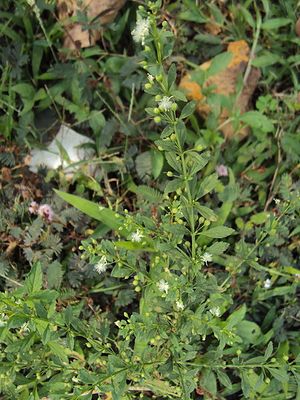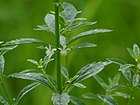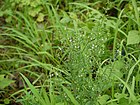Note: This is a project under development. The articles on this wiki are just being initiated and broadly incomplete. You can Help creating new pages.
Difference between revisions of "Scoparia dulcis - Sweet Broom Weed"
m (Prabhakar moved page Sweet Broom Weed (Scoparia dulcis) to Scoparia dulcis - Sweet Broom Weed) |
|||
| Line 2: | Line 2: | ||
| − | '''Scoparia dulcis''' is a species of flowering plant in the plantain family | + | '''Scoparia dulcis''' is a species of flowering plant in the plantain family and It is native to the Neotropics but it can be found throughout the tropical and subtropical world. |
| − | == | + | ==Uses== |
| + | {{Uses|gastralgia}}, {{Uses|dysentery}}, {{Uses|intestinal affections}}, {{Uses|fever}}, {{Uses|enteritis}}, {{Uses|beriberi}}, {{Uses|edema}}, {{Uses|Diarrhea}}, {{Uses|coughs}}, {{Uses|kidney complaintss}}, {{Uses|indigestion}}, {{Uses|colic}}. | ||
| − | + | ==Parts Used== | |
| + | {{Parts Used|Seeds}}. | ||
| − | + | ==Chemical Composition== | |
| + | Palmitic acid, b-sitosterol, glutinol, and a mixture of b-amyrin and isomultiflorenol<ref name="chemical composition"/> | ||
| − | ==Common | + | ==Common names== |
| + | {{Common names|kn=|ml=|sa=|ta=Sarakkotthini|te=|hi=Mithi patti|en=Sweet Broom Weed, Sweet Broom Wort}} | ||
| − | + | ==Properties== | |
| − | + | Reference: Dravya - Substance, Rasa - Taste, Guna - Qualities, Veerya - Potency, Vipaka - Post-digesion effect, Karma - Pharmacological activity, Prabhava - Therepeutics. | |
| − | + | ===Dravya=== | |
| − | == References == | + | ===Rasa=== |
| + | Tikta (Bitter), Kashaya (Astringent) | ||
| + | ===Guna=== | ||
| + | Laghu (Light), Ruksha (Dry), Tikshna (Sharp) | ||
| + | ===Veerya=== | ||
| + | Ushna (Hot) | ||
| + | ===Vipaka=== | ||
| + | Katu (Pungent) | ||
| + | ===Karma=== | ||
| + | Kapha, Vata | ||
| + | ===Prabhava=== | ||
| + | |||
| + | ==Habit== | ||
| + | {{Habit|Annual plantHerb}} | ||
| + | |||
| + | ==Identification== | ||
| + | ===Leaf=== | ||
| + | {{Leaf|Simple|Oblong-elliptic|Leaf Arrangement is Decussate or whorled}}<ref name="Leaf"/> | ||
| + | |||
| + | ===Flower=== | ||
| + | {{Flower|Unisexual|2-4cm long|white|5|Flowers are Solitary or 2, axillary and Flowering throughout the year}} | ||
| + | |||
| + | ===Fruit=== | ||
| + | {{Fruit|ellipsoid|7–10 mm|Fruit are globose capsule and Fruiting throughout the year|septicidal, reticulate|4}} | ||
| + | |||
| + | ===Other features=== | ||
| + | |||
| + | ==List of Ayurvedic medicine in which the herb is used== | ||
| + | * [[Vishatinduka Taila]] as ''root juice extract'' | ||
| + | |||
| + | ==Where to get the saplings== | ||
| + | ==Mode of Propagation== | ||
| + | {{Propagation|Seeds}}. | ||
| + | |||
| + | ==How to plant/cultivate== | ||
| + | A common weed of lowland tropical and subtropical areas, found in areas where it rains all year round and also where there is a prolonged dry season[310 ]. Succeeds in most soils<ref name="How to plant/cultivate"/> | ||
| + | |||
| + | ==Commonly seen growing in areas== | ||
| + | {{Commonly seen|Subtropical}}, {{Commonly seen|Tropical}}. | ||
| + | |||
| + | ==Photo Gallery== | ||
| + | <gallery class="left" caption="" widths="140px" heights="140px"> | ||
| + | Anisillo (in Peru) (3709163233).jpg | ||
| + | |||
| + | |||
| + | Bitterbroom (3709135949).jpg | ||
| + | |||
| + | |||
| + | Bon Dhonya (Bengali- বন ধনিযা) (2661183096).jpg | ||
| + | |||
| + | |||
| + | Broomweed (4825741797).jpg | ||
| + | |||
| + | |||
| + | Chinibuta (in Santal) (3709156161).jpg | ||
| + | |||
| + | </gallery> | ||
| + | |||
| + | ==References== | ||
<references> | <references> | ||
| − | <ref name=" | + | <ref name="chemical composition">[http://www.vjs.ac.vn/index.php/vjchem/article/view/4660 "chemical constituents"]</ref> |
| + | |||
| + | <ref name="Leaf">[https://indiabiodiversity.org/species/show/231128 "morphology"]</ref> | ||
| + | |||
| + | <ref name="How to plant/cultivate">[https://www.pfaf.org/user/Plant.aspx?LatinName=Scoparia+dulcis "Cultivation details"]</ref> | ||
</references> | </references> | ||
| − | == External Links == | + | ==External Links== |
| + | * [http://ijpsr.com/bft-article/pharmacognostic-phytochemical-investigation-pharmacological-evaluation-of-scoparia-dulcis-linn-plant-extracts-for-nephro-protective-activity/?view=fulltext Scoparia dulcis] | ||
| + | * [http://tropical.theferns.info/viewtropical.php?id=Scoparia+dulcis Scoparia dulcis on useful trophical plants] | ||
| + | * [http://www.flowersofindia.net/catalog/slides/Sweet%20Broom%20Weed.html Scoparia dulcis on flowers of india] | ||
| + | * [https://www.jircas.affrc.go.jp/project/value_addition/Vegetables/089.html Scoparia dulcis on jircas.affrc.go.jp] | ||
| − | |||
| − | |||
[[Category:Herbs]] | [[Category:Herbs]] | ||
Revision as of 17:38, 6 June 2018
Scoparia dulcis is a species of flowering plant in the plantain family and It is native to the Neotropics but it can be found throughout the tropical and subtropical world.
Contents
- 1 Uses
- 2 Parts Used
- 3 Chemical Composition
- 4 Common names
- 5 Properties
- 6 Habit
- 7 Identification
- 8 List of Ayurvedic medicine in which the herb is used
- 9 Where to get the saplings
- 10 Mode of Propagation
- 11 How to plant/cultivate
- 12 Commonly seen growing in areas
- 13 Photo Gallery
- 14 References
- 15 External Links
Uses
gastralgia, dysentery, intestinal affections, fever, enteritis, beriberi, edema, Diarrhea, coughs, kidney complaintss, indigestion, colic.
Parts Used
Chemical Composition
Palmitic acid, b-sitosterol, glutinol, and a mixture of b-amyrin and isomultiflorenol[1]
Common names
| Language | Common name |
|---|---|
| Kannada | |
| Hindi | Mithi patti |
| Malayalam | |
| Tamil | Sarakkotthini |
| Telugu | |
| Marathi | NA |
| Gujarathi | NA |
| Punjabi | NA |
| Kashmiri | NA |
| Sanskrit | |
| English | Sweet Broom Weed, Sweet Broom Wort |
Properties
Reference: Dravya - Substance, Rasa - Taste, Guna - Qualities, Veerya - Potency, Vipaka - Post-digesion effect, Karma - Pharmacological activity, Prabhava - Therepeutics.
Dravya
Rasa
Tikta (Bitter), Kashaya (Astringent)
Guna
Laghu (Light), Ruksha (Dry), Tikshna (Sharp)
Veerya
Ushna (Hot)
Vipaka
Katu (Pungent)
Karma
Kapha, Vata
Prabhava
Habit
Identification
Leaf
| Kind | Shape | Feature |
|---|---|---|
| Simple | Oblong-elliptic | Leaf Arrangement is Decussate or whorled |
Flower
| Type | Size | Color and composition | Stamen | More information |
|---|---|---|---|---|
| Unisexual | 2-4cm long | white | 5 | Flowers are Solitary or 2, axillary and Flowering throughout the year |
Fruit
| Type | Size | Mass | Appearance | Seeds | More information |
|---|---|---|---|---|---|
| ellipsoid | 7–10 mm | Fruit are globose capsule and Fruiting throughout the year | septicidal, reticulate | 4 | {{{6}}} |
Other features
List of Ayurvedic medicine in which the herb is used
- Vishatinduka Taila as root juice extract
Where to get the saplings
Mode of Propagation
How to plant/cultivate
A common weed of lowland tropical and subtropical areas, found in areas where it rains all year round and also where there is a prolonged dry season[310 ]. Succeeds in most soils[3]
Commonly seen growing in areas
Photo Gallery
References
External Links
- Ayurvedic Herbs known to be helpful to treat gastralgia
- Ayurvedic Herbs known to be helpful to treat dysentery
- Ayurvedic Herbs known to be helpful to treat intestinal affections
- Ayurvedic Herbs known to be helpful to treat fever
- Ayurvedic Herbs known to be helpful to treat enteritis
- Ayurvedic Herbs known to be helpful to treat beriberi
- Ayurvedic Herbs known to be helpful to treat edema
- Ayurvedic Herbs known to be helpful to treat Diarrhea
- Ayurvedic Herbs known to be helpful to treat coughs
- Ayurvedic Herbs known to be helpful to treat kidney complaintss
- Ayurvedic Herbs known to be helpful to treat indigestion
- Ayurvedic Herbs known to be helpful to treat colic
- Herbs with Seeds used in medicine
- Herbs with common name in Hindi
- Herbs with common name in Tamil
- Herbs with common name in English
- Habit - Annual plantHerb
- Index of Plants which can be propagated by Seeds
- Herbs that are commonly seen in the region of Subtropical
- Herbs that are commonly seen in the region of Tropical
- Herbs





